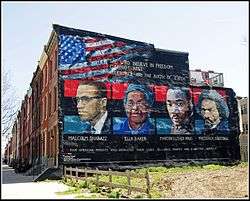Black pride
| Part of racial and political series on |
| Black Power |
|---|
 |
|
History |
|
Organizations
|
|
Black pride is a movement in response to dominant white cultures and ideologies that encourages black people to celebrate black culture and embrace their African heritage.[1] In the United States, it was a direct response to white racism especially during the Civil Rights Movement.[2] Related movements include black power,[2] black nationalism,[2] Black Panthers, Afrocentrism, and black supremacism.
Arts and music
The black pride is a major theme in some works of African American popular musicians. Civil Rights Movement era songs such as The Impressions's hit songs "We're a Winner"[3] and "Keep on Pushing"[4] and James Brown's "Say It Loud – I'm Black and I'm Proud"[4][5] celebrated black pride. Beyoncé's half-time performance at Super Bowl 50, which included homages to Malcolm X and the Black Panthers, has been described by the media as a display of black pride.[6][7]
Beauty and fashion
Beauty standards are a major theme of black pride. Black pride was represented in slogans such as "black is beautiful"[8][9] which challenged white beauty standards.[10] Prior to the black pride movement, the majority of black people straightened their hair or wore wigs.[9] The adoption natural hair styles such as the afro, cornrows, and dreadlocks were seen as expressions of black pride.[9][10][11][12]
In the 1960s-1970s, kente cloth and the Black Panthers uniform were worn in the U.S. as expressions of black pride.[9] Headscarves were sometimes worn by Nation of Islam and other Black Muslim Movement members as an expression of black pride and a symbol of faith.[11] Other women used scarves with African prints to cover their hair.[9]
Maxine Leeds Craig argues that all-black beauty pageants such as Miss Black America were institutionalized forms of black pride created in response to exclusion from white beauty pageants.[11]
International

Brazil
The black pride movement is very prevalent in Brazil, especially throughout their poorer population, and it is found in the Brazilian funk music genre that began to arise in the late 1960s, as also in the called Funk carioca, that emerged in late 1980s. Both the origin of Brazilian funk and Funk carioca reflects Brazilian black resistance. Ethnomusicologist George Yúdice states that youths were engaging black culture mediated by a U.S. culture industry met with many arguments against their susceptibility to cultural colonization. Although it borrows some ingredients from hip hop, its style still remains unique to Brazil (mainly Rio de Janeiro and also São Paulo).[13]
Jamaica
Black pride has been a central theme of the originally Jamaican Rastafari movement since the second half of the 20th century. It has been described as "a rock in the face of expressions of white superiority."[14]
United States
The slogan has been used in the United States by African Americans to celebrate heritage[1] and personal pride. The black pride movement is closely linked with the developments of the American civil rights movement and Black Power movement,[2][15] during which figures such as Martin Luther King, Jr., A. Philip Randolph, Malcolm X and Stokely Carmichael spoke out against the conditions of the United States' segregated society, and lobbied for better treatment for people of all races.
Critiques
Gary Kamiya has criticized the black pride movement, saying that to the extreme, black pride would cause people of African descent to fail to separate their personal identities from their race.[16]
See also
References
- 1 2 Lois Tyson (2001). Learning for a Diverse World: Using Critical Theory to Read and Write about Literature. Psychology Press. pp. 208–209. ISBN 978-0-8153-3774-4.
Because the dominant white culture in America treated African Americans as subalterns rather than full American citizens and full human beings, the Black Pride movement encouraged black Americans to look to Africa for their cultural origins.
- 1 2 3 4 Wayne C. Glasker (1 June 2009). Black Students in the Ivory Tower: African American Student Activism at the University of Pennsylvania, 1967-1990. Univ of Massachusetts Press. p. 28. ISBN 1-55849-756-0.
In 1966 the Black Power-black nationalist-black pride movements emerged as equal and opposite reactions to white racism as a reaction of the biracial civil rights movement.
- ↑ Pruter, Robert (1991). Chicago Soul. Champaign, IL: University of Illinois Press. ISBN 0-252-06259-0.
- 1 2 Koskoff, Ellen (2005). Music Cultures in the United States: An Introduction. New York: Routledge. ISBN 0-415-96589-6.
- ↑ Jones, Melvyn "Deacon" (2008). The Blues Man: 40 Years with the Blues Legends. Bloomington, IN: AuthorHouse. ISBN 978-1-4343-7571-1.
- ↑ Ex, Kris (10 February 2016). "Why Are People Suddenly Afraid of Beyonce's Black Pride?". Billboard. Retrieved 11 February 2016.
- ↑ Gass, Henry (8 February 2016). "Beyoncé's black pride moment at the Super Bowl". The Christian Science Monitor. Retrieved 11 February 2016.
- ↑ Meeta Jha (16 September 2015). The Global Beauty Industry: Colorism, Racism, and the National Body. Taylor & Francis. p. 46. ISBN 978-1-317-55795-1.
- 1 2 3 4 5 José Blanco F.; Mary Doering; Patricia Kay Hunt-Hurst; Heather Vaughan Lee, eds. (2016). Clothing and Fashion: American Fashion from Head to Toe. ABC-CLIO. p. 52. ISBN 978-1-61069-310-3.
- 1 2 Noliwe M. Rooks (1996). Hair Raising: Beauty, Culture, and African American Women. Rutgers University Press. ISBN 978-0-8135-2312-5.
- 1 2 3 Maxine Leeds Craig (24 May 2002). Ain't I a Beauty Queen? : Black Women, Beauty, and the Politics of Race: Black Women, Beauty, and the Politics of Race. Oxford University Press. ISBN 978-0-19-803255-7.
- ↑ Victoria Sherrow (January 2006). Encyclopedia of Hair: A Cultural History. Greenwood Publishing Group. ISBN 978-0-313-33145-9.
- ↑ Yúdice 1994
- ↑ Rastafari and slavery
- ↑ "Rising Black Consciousness". Virginia Historical Society. Retrieved February 13, 2016.
As the civil rights movement gained ground, removing the stigma of inferiority not only in schools but throughout society, black pride increased.
- ↑ cablinasian like me
Further reading
- Yúdice, George (1994), "The Funkification of Rio", in Ross, Andrew; Rose, Tricia, Microphone Fiends: Youth Music and Youth Culture, London: Routledge, pp. 193–220, ISBN 978-0-415-90907-5